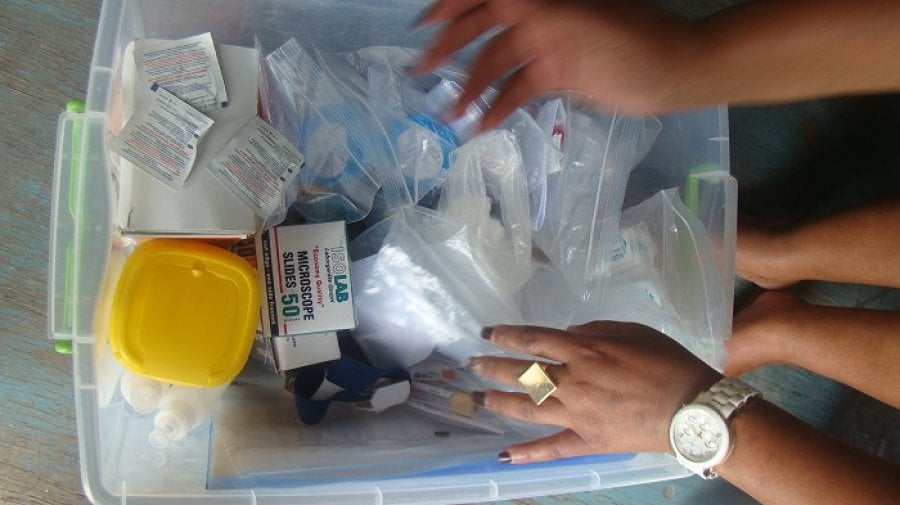Targeted STI testing detects more infection in young women than men in rural South Africa
28 February 2018 London School of Hygiene & Tropical Medicine London School of Hygiene & Tropical Medicine https://lshtm.ac.uk/themes/custom/lshtm/images/lshtm-logo-black.png
Young women in rural South Africa are more likely to carry two common sexually transmitted infections (STIs) than young men, according to a new proof of concept study published in PLOS Medicine.
The study involving 450 young people was led by the London School of Hygiene & Tropical Medicine and the Africa Research Health Institute. It found that young women were more than twice as likely to be infected with chlamydia (5% in men and 11% in women), and nearly twice as likely to be infected with genital herpes (17% in men and 29% in women).
It also found that 42% of young women had dysbiotic condition call bacterial vaginosis (BV) - a known risk factor for poor birth outcomes and HIV acquisition - and five times as likely to be infected with a tiny parasite called Trichomonas vaginalis (0.6% in men and 5% in women).
The authors say the study shows vital STI prevalence data can be efficiently obtained in areas where the impact of STIs and their consequences may be greatest, such as sub-Saharan Africa. They also note that future studies should be carried out in conjunction with research that measures STI/BV prevalence in high-risk populations, such as female sex workers, to provide robust prevalence estimates.
The impact of STIs in sub-Saharan Africa is significant; left untreated they can cause serious health complications and permanent damage. Chlamydia, a curable STI, is a major cause of pelvic inflammatory disease, chronic pelvic pain and infertility. Infected women are at a higher risk of acquiring HIV, and in pregnant women, it can cause pneumonia and eye infections in newborns.
Although sub-Saharan Africa is known to have a high prevalence of HIV, less is known about the burden of STIs, especially among young people, and risk factors for acquiring STIs. Having accurate data on STI prevalence and incidence is vital for prevention and programme planning and the World Health Organization made this a priority in their Strategy on Sexually Transmitted Infections.
Suzanna Francis, Assistant Professor and lead author from the London School of Hygiene & Tropical Medicine said: “Adolescents and young adults are particularly vulnerable to STIs, yet STI prevalence is largely unknown in many high HIV prevalence settings, as these types of studies can be expensive to carry out. To date there have been few population estimates of the burden of STIs among young adults known to be at high risk of infection, such as adolescent girls and young women, and no studies among men. These estimates are crucial so that we can detect increases in STIs, and plan effective prevention and control programmes.”
In this study, conducted in the rural uMkhanyakude district of KwaZulu-Nata which has a high rate of HIV, researchers collected samples from participants’ home, which were then sent to a central laboratory and tested for chlamydia, gonorrhoea, syphilis, trichomoniasis and genital herpes (herpes simplex virus type 2). Women were additionally tested for bacterial vaginosis.
This targeted STI testing was found to be acceptable to participants, with 69% of individuals contactable and eligible enrolled in the study. Participants, who were also interviewed, reported that the testing was easy, not painful and they did not experience any anxiety or embarrassment.
Suzanna Francis said: “We found a high burden of STIs in this study, most of which were asymptomatic. Current STI control programmes in low and middle-income countries rely on people experiencing symptoms in order to be diagnosed, which misses many infections. Incorporating the results of STI surveys like this, into existing networks of health and demographic surveillance sites is an excellent opportunity to obtain STI prevalence estimates that are badly needed.
The authors acknowledge limitations of their work, including that the study was limited by a time constraint of three months in which fewer participants were contacted and enrolled than envisaged.
This study was funded by the Wellcome Trust, the Medical Research Council and ViiV Healthcare.
Publication
Francis SC, Mthiyane TN, Baisley K, Mchunu SL, Ferguson JB, Smit T, et al. (2018) Prevalence of sexually transmitted infections among young people in South Africa: A nested survey in a health and demographic surveillance site. PLoS Med. DOI: 10.1371/journal.pmed.1002512
LSHTM's short courses provide opportunities to study specialised topics across a broad range of public and global health fields. From AMR to vaccines, travel medicine to clinical trials, and modelling to malaria, refresh your skills and join one of our short courses today.